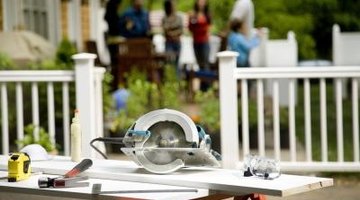How to Attach a New Pipe to the Main Sewer Line
Most household sewer lines are made of either ABS (Acrylonitrile Butadiene Styrene) or PVC (Polyvinyl chloride) plastic. The home's main sewer line, either three or four inches in diameter, runs from the basement/buildup area underground to the city sewer, or to a private septic tank. Most individual sewer lines from your water fixtures connect to the main sewer line via a connecting coupling. This coupling is the same diameter as the main sewer line, and has a side spout that fits to the sewer pipe running to the water fixture.

-
Mark the main sewer line pipe at the point where the new sewer pipeline will attach to it. Make a second mark on the sewer line 2 inches along from the first mark. Make a straight perpendicular cut through the main sewer line at both marks using a circular saw or handsaw --- the two cuts will be parallel with each other. Take out the 2-inch pipe section. Use 80-grit sandpaper to remove all burrs from the existing sawed pipe ends.
-
Brush PVC primer around the outside of both sawed pipe ends, to a width of 3/4 inch --- both primer and cement tins have brushes attached to their lids. Next, prime the inside ends of a PVC connecting coupling. Brush PVC cement on all four primed areas.
-
Squeeze the connecting coupling between the main line's sawed pipe ends, pushing the pipe ends into each end of the coupling --- make sure the coupling's side-spout faces upward and in the direction of the water fixture it will eventually connect to. Hold the pipes to the coupling for 10 seconds to let the cement set.
References
Tips
- Older homes can have sewer lines made from lead, cast iron or clay. In these cases, PVC or ABS pipe is used for the new pipeline, while the connecting coupling us made of flexible rubber. The ends of the couplings push onto the pipe, and hose clamps surrounding the ends of the coupling are tightened in place with a screwdriver. Clay and lead pipes are cut with a reciprocating saw and carbide blade, whereas cast iron is cut using a snap cutter.
- If cutting into an ABS main sewer line, use an ABS connecting coupling and ABS cement. No primer is needed.
- The first new sewer pipe section will be cut to length and installed with primer and cement into the connecting coupling's side spout. The second new pipe section will join to the end of the first section with primer, cement and a coupling, as will all other new pipe sections, until the water fixture is reached.
Writer Bio
Steve Sloane started working as a freelance writer in 2007. He has written articles for various websites, using more than a decade of DIY experience to cover mostly construction-related topics. He also writes movie reviews for Inland SoCal. Sloane holds a Bachelor of Arts in creative writing and film theory from the University of California, Riverside.
Photo Credits
- David Sacks/Lifesize/Getty Images
More Articles



